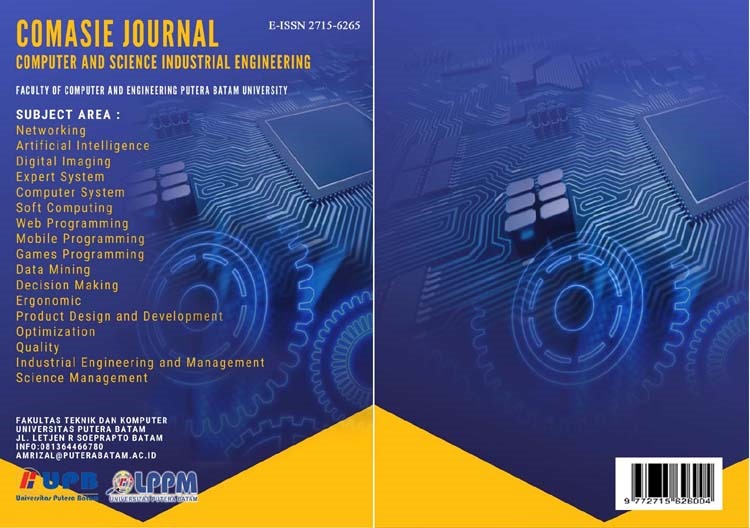PREDIKSI PENYAKIT DIABETES MENGGUNAKAN ALGORITMA REGRESI LOGISTIK
DOI:
https://doi.org/10.33884/comasiejournal.v11i4.9177Keywords:
Diabetes Prediction, Logistical Regression, Risk Prediction, Diabetes Variable, Healthy Lifestyle GuidanceAbstract
The annual count of individuals afflicted with diabetes is rising. As to a survey carried out by the International Diabetes Federation (IDF), the global diabetes population is approximated to be 537 million by 2021, and this number is projected to increase further to exceed 780 million by 2045. The study's primary goal is to diagnose and forecast whether or not a patient has diabetes. The approach makes use of logistic regression, a statistical tool for modelling individual classifications of diabetes presence or absence. According to the diabetes risk prediction results, 43% of respondents gave consideration to the condition. Consequently, it has been demonstrated that normalisation enhances the accuracy of diabetes risk prediction using logistic regression methods. Based on the variables included, it is anticipated that the predictions made by this model will serve as a guide for the general public in understanding healthy living and diabetes prevention.
References
A’yuniyah, Q., & Reza, M. (2023). Penerapan Algoritma K-Nearest Neighbor Untuk Klasifikasi Jurusan Siswa Di Sma Negeri 15 Pekanbaru. IJIRSE: Indonesian Journal of Informatic Research and Software Engineering, 3(1), 1–7.
Cahyani, Q. R., Finandi, M. J., Rianti, J., Arianti, D. L., & Putra, A. D. P. (2022). Prediksi Risiko Penyakit Diabetes menggunakan Algoritma Regresi Logistik. JOMLAI: Journal of Machine Learning and Artificial Intelligence, 1(2), 1–8.
Fitriyani, N., Amalia, D. R., Handayani, H. H., & Masruriyah, A. F. N. (2023). Aplikasi Berbasis Web Berdasarkan Model Klasifikasi Algoritma SVM dan Logistic RegressionTerhadap Data Diabetes. Riset Dan E-Jurnal Manajemen Informatika Komputer, 7(4), 1–10.
Indini, D. P., Siburian, S. R., Nurhasanah, Utomo, D. P., & Mesran. (2022). IMPLEMENTASI ALGORITMA DBSCAN UNTUK CLUSTERING SELEKSI PENENTUAN MAHASISWA YANG BERHAK MENERIMA BEASISWA YAYASAN. 1–8.
Isnain, A. R., Sakti, A. I., Alita, D., & Marga, N. S. (2021). SENTIMEN ANALISIS PUBLIK TERHADAP KEBIJAKAN LOCKDOWN PEMERINTAH JAKARTA MENGGUNAKAN ALGORITMA SVM. Jurnal Data Mining Dan Sistem Informasi, 2(1), 1–7.
Nasrullah, A. H. (2021). IMPLEMENTASI ALGORITMA DECISION TREEUNTUK KLASIFIKASI PRODUK LARIS. Jurnal Ilmiah Ilmu Komputer, 7(2), 1–7.
Pamuji, F. Y., & Ramadhan, V. P. (2021). Komparasi Algoritma Random Forest Dan Decision Tree Untuk Memprediksi Keberhasilan Immunotheraphy. Jurnal Teknologi Dan Manajemen Informatika, 7(1), 1–5.
Pratama, R., Herdiansyah, M. I., Syamsuari, D., & Syazili, A. (2023). Prediksi Customer Retention Perusahaan Asuransi Menggunakan Machine Learning. Jurnal SISFOKOM (Sistem Informasi Dan Komputer, 12(1), 1–10.
Purwono, Wirasto, A., & NIsa, K. (2021). Komparasi Algoritma Machine Learning Untuk Klasifikasi Kelompok Obat. JURNAL SISFOTENIKA, 11(2), 1–12.
Putra, R. P., Zebua, R. S. Y., Budiman, Rahayu, P. W., Bangsa, M. T. A., Zulfadhilah, M., Choirina, P., Wahyudi, F., & Andiyan, A. (2024). Data Mining Algoritma dan Penerapannya (Vol. 1).
Sadewo, M. G., Eriza, A., Windarto, A. P., & Hartama, D. (2019). Algoritma K-Means Dalam Mengelompokkan Desa/Kelurahan Menurut Keberadaan Keluarga Pengguna Listrik dan Sumber Penerangan Jalan Utama Berdasarkan Provinsi. Seminar Nasional Teknologi Komputer & Sains (SAINTEKS), 1–8.
Sulistiyawati, A., & Supriyanto, E. (2021). Implementasi Algoritma K-means Clustering dalam Penetuan Siswa Kelas Unggulan. Jurnal TEKNO KOMPAK, 15(2), 1–12.














